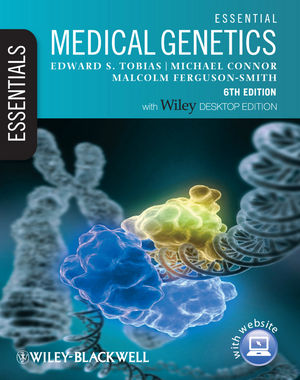Essential Medical Genetics, Includes Desktop Edition, 6th EditionISBN: 978-1-4051-6974-5
Paperback
344 pages
March 2011, Wiley-Blackwell
 |
||||||
Acknowledgements ix
How to get the best out of your textbook x
Part 1: Basic principles 1
1 Medical genetics in perspective 3
Scientific basis of medical genetics 5
Clinical applications of medical genetics 9
2 The human genome 13
Structure and organisation of the genome 14
Gene identification 14
Th e Human Genome Project 14
3 Nucleic acid structure and function 23
Nucleic acid structure 24
Nucleic acid function 26
Gene regulation 29
DNA replication 31
Mutation types, eff ects and nomenclature 32
4 DNA analysis 41
Basic methods 42
Mutation detection 43
Indirect mutant gene tracking 52
Analysis of DNA length polymorphisms 53
Analysis of single-nucleotide polymorphisms 54
5 Chromosomes 57
Chromosome structure 58
Chromosome analysis 59
Chromosome heteromorphisms 65
Chromosomes in other species 66
Mitochondrial chromosomes 68
Mitosis 69
6 Gametogenesis 73
Meiosis 74
Spermatogenesis 76
Oogenesis 78
Fertilisation 78
X-inactivation and dosage compensation 79
Sex chromosome aberrations 80
Sex determination and differentiation 83
Genomic imprinting (parental imprinting) 83
7 Chromosome aberrations 89
Numerical aberrations 90
Structural aberrations 92
Cytogenetic and molecular methods for the detection of chromosomal aberrations 100
Identification of the chromosomal origin of complex structural rearrangements 107
Other aberrations 111
8 Typical Mendelian inheritance 117
Introduction to autosomal single-gene inheritance 118
Autosomal dominant inheritance 118
Autosomal recessive inheritance 120
Introduction to sex-linked inheritance 123
X-linked recessive inheritance 125
X-linked dominant inheritance 127
Y-linked inheritance (holandric inheritance) 128
9 Atypical Mendelian inheritance 131
Genetic anticipation 132
Pseudoautosomal inheritance 134
Autosomal dominant inheritance with sex limitation 134
Pseudodominant inheritance 134
X-linked dominant inheritance with male lethality 135
Mosaicism 135
Modifi er genes and digenic inheritance 135
Uniparental disomy 136
Imprinting disorders 136
10 Non-Mendelian inheritance 141
Multifactorial disorders 142
Somatic cell genetic disorders 147
Mitochondrial disorders 147
11 Medical genetics in populations 151
Selection for single-gene disorders 152
Founder effect and genetic drift for single-gene disorders 153
Altered mutation rate for single-gene disorders 154
Linkage analysis and the International Hapmap Project 154
Human population evolution and migration 155
Part 2: Clinical applications 161
12 Genetic assessment, genetic counselling and reproductive options 163
Communication of advice 164
Special points in counselling 168
Prenatal diagnosis 170
Amniocentesis 170
Chorionic villus sampling 174
Cordocentesis, fetal skin biopsy and fetal liver biopsy 175
Ultrasonography 175
Fetal cells in the maternal circulation 175
Free fetal DNA and RNA detection 175
Preimplantation genetic diagnosis 176
13 Family history of cancer 179
General principles 180
Tumour suppressor genes 181
Genes involved in DNA repair mechanisms 187
Oncogenes 187
Other cancer-related genes 189
Genetic counselling aspects of cancer 189
Common familial cancer predisposition syndromes 189
14 Family history of common adult-onset disorder 199
General principles 200
Diabetes mellitus: common and monogenic forms 200
Dementia: Alzheimer disease, Huntington disease, prion diseases and other causes 202
15 Strong family history – typical Mendelian disease 209
Cystic fibrosis 210
Duchenne and Becker muscular dystrophies 212
Neurofi bromatosis type 1 214
16 Strong family history – other inheritance mechanisms 219
Myotonic dystrophy 220
Fragile X syndrome 221
Mitochondrial disorder 222
Imprinting-related disorder 223
Chromosomal translocation 224
17 Screening for disease and for carriers 229
Prenatal screening 230
Neonatal screening 233
Carrier detection in the adult population 234
Presymptomatic screening of adults 237
18 Family history of one or more congenital malformations 241
Aetiology 242
Chromosomal disorders 243
Neural tube defects 247
Teratogenic eff ects 250
Multiple malformation syndromes 253
Part 3: Electronic databases – a user's guide 265
19 Electronic databases – a user's guide 267
Finding information regarding specifi c conditions and names of associated genes 268
Laboratories undertaking genetic testing 270
Patient information and support groups 270
Gene- and protein-specifi c sequence, structure, function and expression information 272
Nucleotide sequences and human mutations 281
Automatic primer design tools 281
Displaying map data for genes and markers 287
Online missense mutation analysis tools 288
Computer-aided syndrome diagnosis 293
Professional genetics societies 297
Th e Human Genome Project: ethics and education 297
Self-assessment – answers 305
Appendix 1: Odds, probabilities and applications of Bayes’ theorem 312
Appendix 2: Calculation of the coeffi cients of relationship and inbreeding 314
Appendix 3: Population genetics of single-gene disorders 315
Appendix 4: Legal aspects 317
Glossary 318
Index 324



